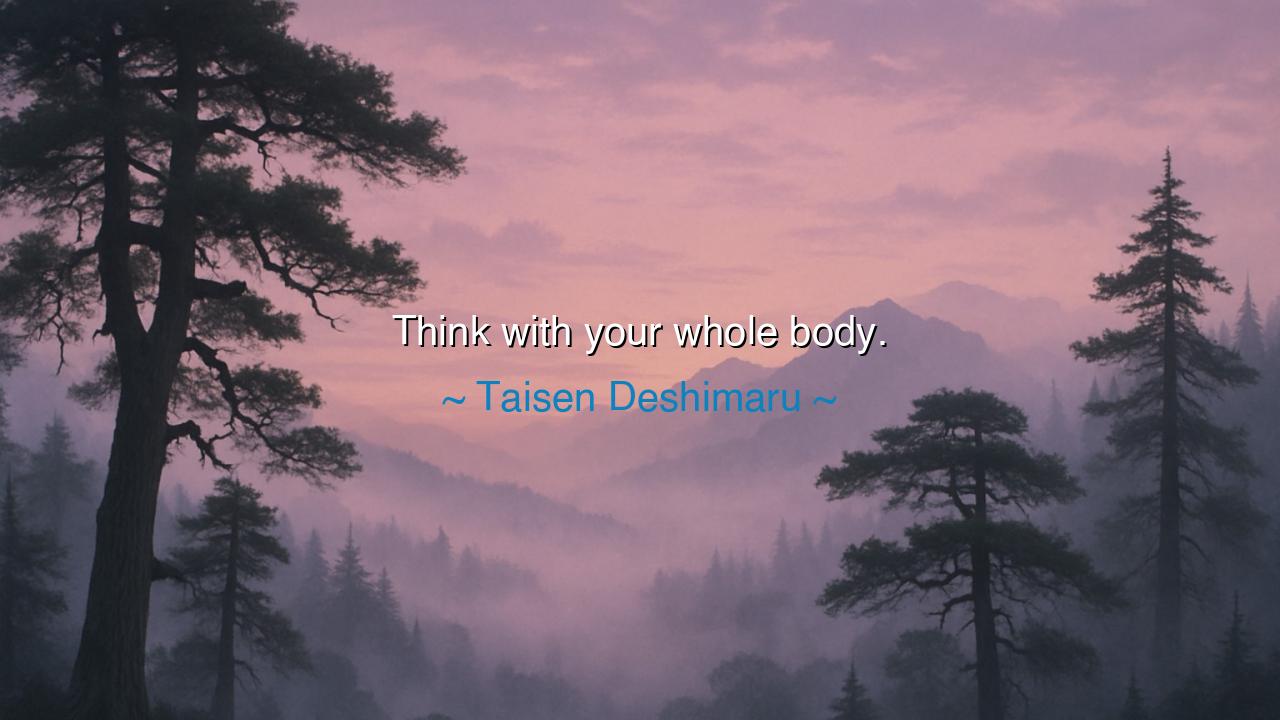
Think with your whole body.






In the profound and tranquil words of Taisen Deshimaru, the Zen master who brought the wisdom of Japan’s monasteries to the Western world, we encounter a teaching both mysterious and luminous: “Think with your whole body.” Though brief, this phrase carries the weight of centuries of Eastern philosophy and the pulse of living experience. It calls upon us to awaken — not only the mind that reasons but the body that feels, the heart that knows, and the breath that connects us to life itself. It is not merely a call to thought, but to embodied wisdom — to live as one, undivided.
The origin of this quote lies deep within the Zen tradition, where Deshimaru, a disciple of Kodo Sawaki, sought to express the essence of zazen, or seated meditation. In Zen, thinking is not an act of the mind alone — it is the rhythm of the entire being. When Deshimaru said “think with your whole body,” he was not suggesting we abandon reason, but that we unite it with the silent intelligence of the flesh, the breath, the senses, and the spirit. For in the practice of Zen, thought is not a stream of words but a state of awareness, a harmony between mind and matter. The body itself becomes a vessel of wisdom — the living ground of insight.
In the West, we are taught to divide: the mind is praised as the ruler, the body its servant. But Deshimaru’s words tear down this illusion. He reminds us that true understanding is wholeness — that intellect without embodiment is like a bird with one wing. To “think with your whole body” is to remember that knowing is not only in the head but in the posture, in the breath, in the quiet sensation of being alive. The ancient masters of martial arts knew this truth well. The swordsman who hesitates to calculate loses his flow; the master who moves from pure awareness becomes unstoppable. Thought must live in motion, in muscle, in breath.
Consider the story of Miyamoto Musashi, the legendary samurai and philosopher. In his classic Book of Five Rings, he spoke of the warrior who achieves victory not through intellect alone, but through a harmony between body, spirit, and instinct. He wrote, “From one thing, know ten thousand things.” In battle, there is no time to analyze — the mind must act as swiftly as the sword. Musashi’s mastery came from thinking with his whole body, from moving so deeply in tune with reality that there was no separation between perception and action. His teaching, like Deshimaru’s, reveals that wisdom is not something we think — it is something we become.
To think with the whole body, then, is to enter the state the Zen monks call mushin, or “no-mind” — not a lack of thought, but the freedom from the noise of fragmented thinking. It is the state of the artist when brush and spirit are one, of the musician who loses herself in the melody, of the runner who no longer feels his legs but becomes pure motion. In that moment, the boundary between thinker and thought disappears. The body becomes an instrument of consciousness, and life itself flows through it without resistance. This is the wisdom Deshimaru wished to pass on — that enlightenment is not an idea to grasp, but a presence to inhabit.
But his teaching is not only for monks or warriors; it is for every soul that lives in the modern age of disconnection. We live surrounded by noise — thought divorced from feeling, speed divorced from stillness. To think with the whole body is to slow down, to breathe, to listen. It is to let the heart, the gut, and the hands join in decision. It is to walk with awareness of each step, to speak with sincerity in each word, to listen with the entire being, not just the ear. The wisdom of the body is older than the mind; it remembers what the intellect forgets.
Let this, then, be the lesson of Deshimaru’s words: seek not to conquer thought, but to embody it. Sit quietly and feel the breath as it rises and falls — that is thinking. Work with your hands, fully present — that is thinking. Walk beneath the sky, hearing the wind as it brushes your face — that too is thinking. When mind and body are one, every act becomes a meditation, and every moment, a revelation.
And so, dear listener, remember this ancient truth: wisdom lives not in the head, but in the harmony of the whole being. To “think with your whole body” is to live awake — to act without hesitation, to feel without fear, to be wholly present in the miracle of existence. The mind may dream of truth, but the body touches it. Think, then, not as a fragment, but as a universe entire — for in doing so, you will discover the quiet brilliance of being fully, gloriously alive.






AAdministratorAdministrator
Welcome, honored guests. Please leave a comment, we will respond soon